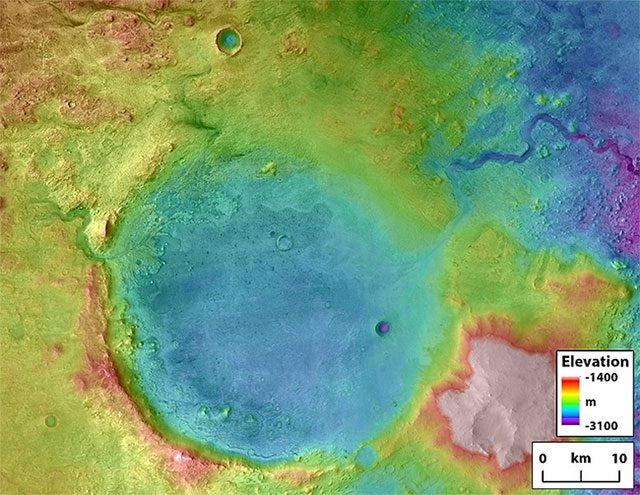The NASA robot is working in Jezero Crater – a massive Martian impact crater that has repeatedly shown evidence of an oasis of life – continues to uncover treasures.
According to Science Alert, a research team from the University of California, Los Angeles (UCLA, USA) and the University of Oslo (Norway) analyzed data from the ground-penetrating radar of Perseverance, one of the two rovers exploring Mars for NASA.
They discovered an unusual signal: The rock layers beneath Jezero Crater are tilting in a strange manner.

Jezero Crater – the ancient “alien oasis” that NASA’s Perseverance robot is exploring – (Photo: NASA)
Jezero Crater is a massive impact crater located in the Syrtis Major Planum region, between the Northern Lowlands and the Southern Highlands of Mars. It spans up to 45 km and may have once been an ancient lake, teeming with life, as previous studies have revealed.
This area was chosen as the landing site for Perseverance, which touched down on the Red Planet in 2021. Similar to the older and more famous Curiosity rover, the mission of this NASA robot is to search for signs of past life by studying the planet’s geology and collecting samples to send back to Earth.
The area where Perseverance operates is where scientists have previously discovered large deposits of rock and clay minerals that settled at the western edge, where water once flowed into the crater to form the ancient lake.
Returning to the tilted rock layers, Earth, Planet, and Space professor David Page from UCLA noted two possibilities.
- First, it could be due to rock layers formed by magma from an ancient volcanic event, cooling, solidifying, and settling.
- Second, these layers could be sediments, a phenomenon commonly observed in water environments on Earth. In this case, it reveals an “Earth-like feature,” which is a type of rock stacked along the mountainside like giant steps beside a highway as you drive through.
This once again shows that Jezero Crater contains many characteristics similar to Earth’s world, landscapes created by a mixed, highly dynamic terrain, with water and potentially ancient treasures of life.
The discovery also indicates that samples from this area will provide a clearer picture of how and when Mars had flowing water on its surface – for how long and whether there were interruptions.
It will also highlight how and when Mars transitioned to its extremely cold and dry environment today, as well as provide the ultimate answer to whether this planet could have been filled with life like Earth. Currently, Perseverance has collected the necessary samples, which will soon be brought back to Earth.
The research was recently published in the scientific journal Science Advances.


















































